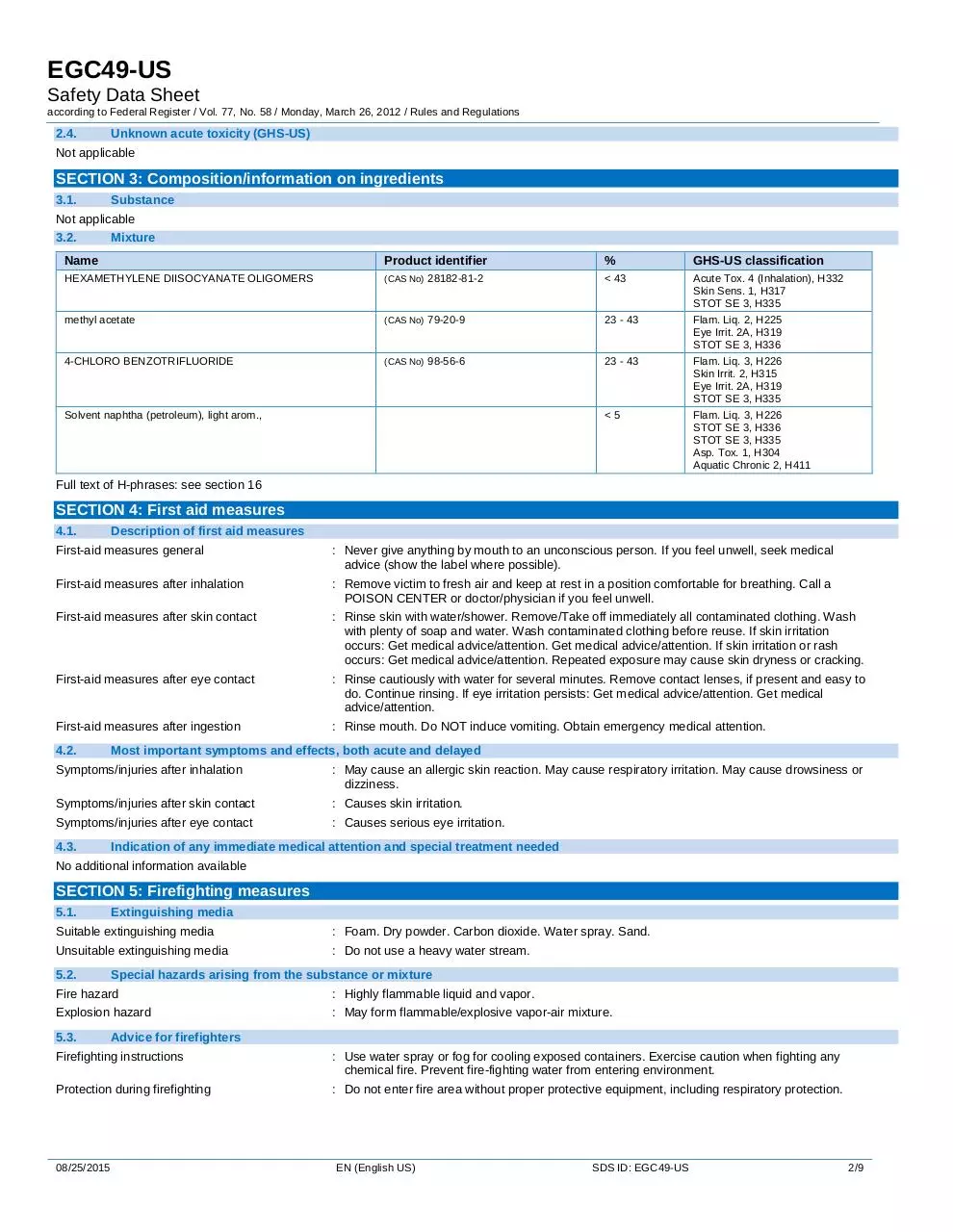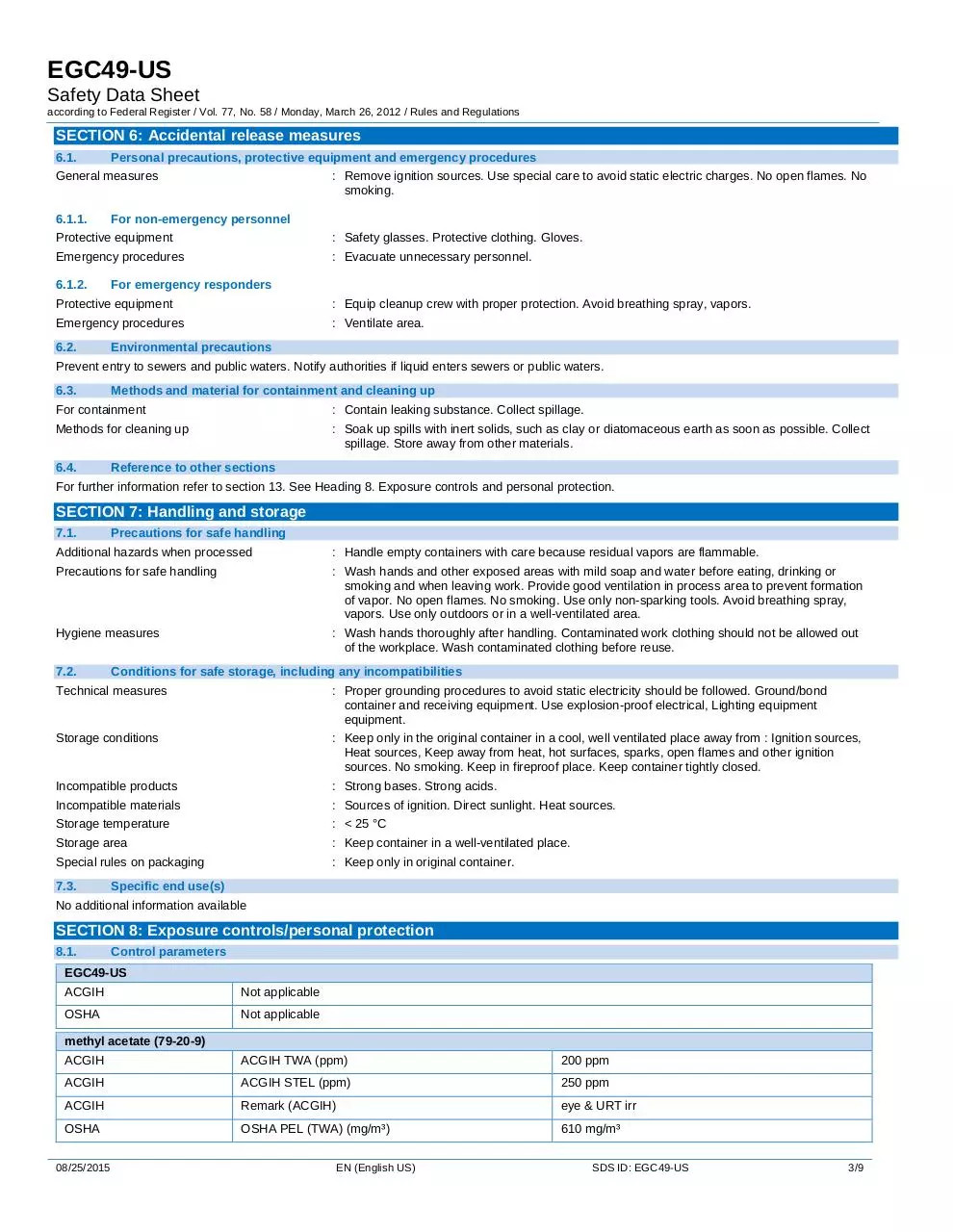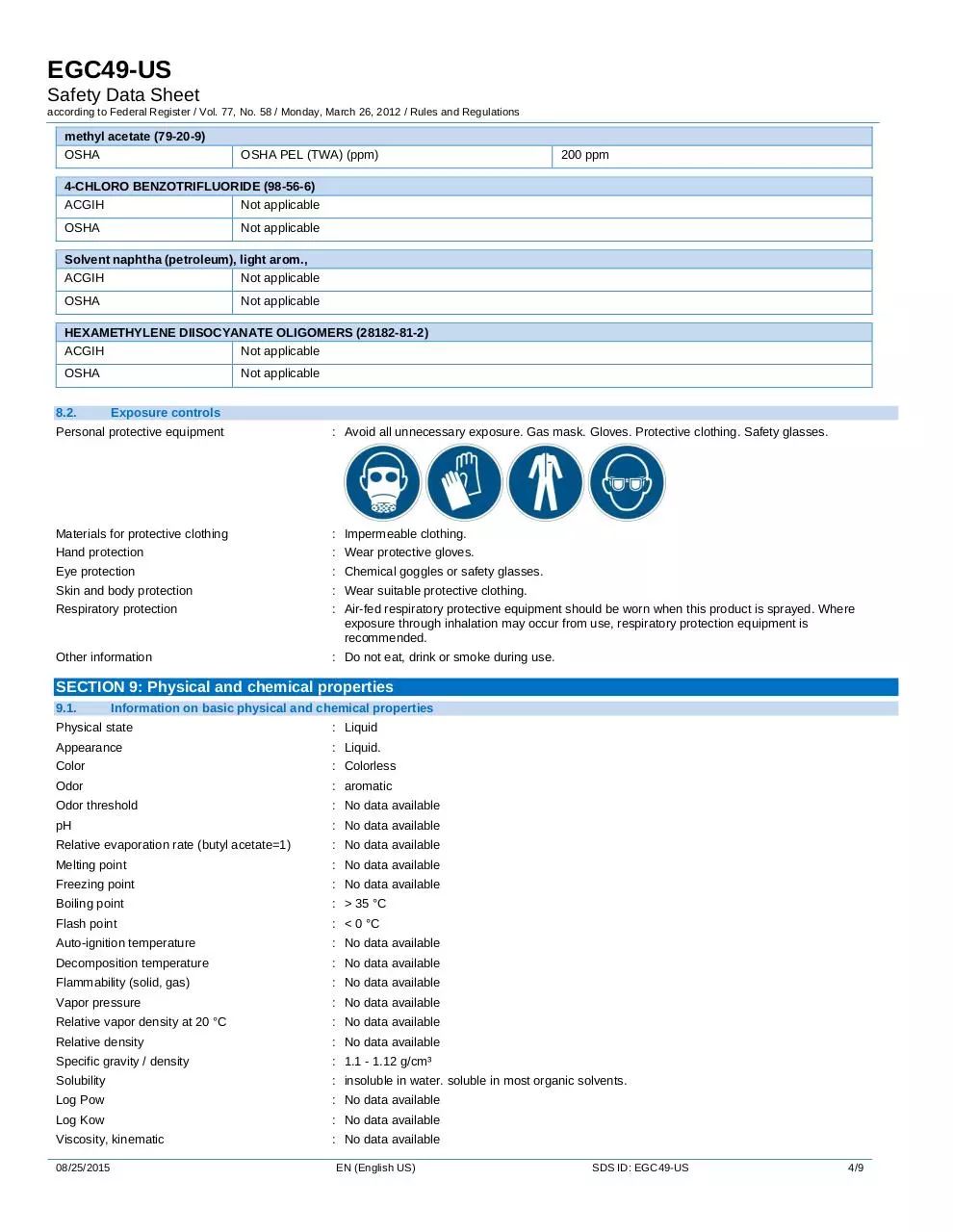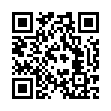EGC49 US SDS EN (PDF)
File information
This PDF 1.5 document has been generated by Microsoft® Word 2010, and has been sent on pdf-archive.com on 01/03/2016 at 19:19, from IP address 73.183.x.x.
The current document download page has been viewed 622 times.
File size: 328.66 KB (9 pages).
Privacy: public file





File preview
EGC49-US
Safety Data Sheet EGC49-US
according to Federal Register / Vol. 77, No. 58 / Monday, March 26, 2012 / Rules and Regulations
Date of issue: 08/11/2015
Version: 1.0
SECTION 1: Identification of the substance/mixture and of the company/undertaking
1.1.
Product identifier
Product form
: Mixture
Product name
: EGC49-US
Product group
: 2K Hardener
1.2.
Relevant identified uses of the substance or mixture and uses advised against
1.3.
Details of the supplier of the safety data sheet
U-POL US Inc
108 Commerce Way
Stockertown
PA 18083 - USA
T 1-800-340-7824 - F 1-800-787-5150
technical.department@u-pol.com - www.u-pol.com
1.4.
Emergency telephone number
Emergency number
: CHEMTREC - 1-800-424-9300 ( UK +44 (0) 1933 230310 (07:30 - 17:00hrs UK time) )
SECTION 2: Hazards identification
2.1.
Classification of the substance or mixture
GHS-US classification
Flam. Liq. 2
Skin Irrit. 2
Eye Irrit. 2A
Skin Sens. 1
STOT SE 3
STOT SE 3
H225
H315
H319
H317
H336
H335
Full text of H-phrases: see section 16
2.2.
Label elements
GHS-US labeling
Hazard pictograms (GHS-US)
:
Signal word (GHS-US)
: Danger
Hazard statements (GHS-US)
: H225 - Highly flammable liquid and vapor
H315 - Causes skin irritation
H317 - May cause an allergic skin reaction
H319 - Causes serious eye irritation
H335 - May cause respiratory irritation
H336 - May cause drowsiness or dizziness
Precautionary statements (GHS-US)
: P210 - Keep away from heat, hot surfaces, open flames, sparks. - No smoking
P261 - Avoid breathing fume, spray, vapors
P264 - Wash hands thoroughly after handling
P280 - Wear face protection, protective clothing, protective gloves
P302+P352 - If on skin: Wash with plenty of water
P305+P351+P338 - If in eyes: Rinse cautiously with water for several minutes. Remove contact
lenses, if present and easy to do. Continue rinsing
P501 - Dispose of contents/container to hazardous or special waste collection point, in
accordance with local, regional, national and/or international regulation
GHS02
2.3.
GHS07
Other hazards
No additional information available
08/25/2015
EN (English US)
SDS ID: EGC49-US
Page 1
EGC49-US
Safety Data Sheet
according to Federal Register / Vol. 77, No. 58 / Monday, March 26, 2012 / Rules and Regulations
2.4.
Unknown acute toxicity (GHS-US)
Not applicable
SECTION 3: Composition/information on ingredients
3.1.
Substance
Not applicable
3.2.
Mixture
Name
Product identifier
%
GHS-US classification
HEXAMETHYLENE DIISOCYANATE OLIGOMERS
(CAS No) 28182-81-2
< 43
Acute Tox. 4 (Inhalation), H332
Skin Sens. 1, H317
STOT SE 3, H335
methyl acetate
(CAS No) 79-20-9
23 - 43
Flam. Liq. 2, H225
Eye Irrit. 2A, H319
STOT SE 3, H336
4-CHLORO BENZOTRIFLUORIDE
(CAS No) 98-56-6
23 - 43
Flam. Liq. 3, H226
Skin Irrit. 2, H315
Eye Irrit. 2A, H319
STOT SE 3, H335
<5
Flam. Liq. 3, H226
STOT SE 3, H336
STOT SE 3, H335
Asp. Tox. 1, H304
Aquatic Chronic 2, H411
Solvent naphtha (petroleum), light arom.,
Full text of H-phrases: see section 16
SECTION 4: First aid measures
4.1.
Description of first aid measures
First-aid measures general
: Never give anything by mouth to an unconscious person. If you feel unwell, seek medical
advice (show the label where possible).
First-aid measures after inhalation
: Remove victim to fresh air and keep at rest in a position comfortable for breathing. Call a
POISON CENTER or doctor/physician if you feel unwell.
First-aid measures after skin contact
: Rinse skin with water/shower. Remove/Take off immediately all contaminated clothing. Wash
with plenty of soap and water. Wash contaminated clothing before reuse. If skin irritation
occurs: Get medical advice/attention. Get medical advice/attention. If skin irritation or rash
occurs: Get medical advice/attention. Repeated exposure may cause skin dryness or cracking.
First-aid measures after eye contact
: Rinse cautiously with water for several minutes. Remove contact lenses, if present and easy to
do. Continue rinsing. If eye irritation persists: Get medical advice/attention. Get medical
advice/attention.
First-aid measures after ingestion
: Rinse mouth. Do NOT induce vomiting. Obtain emergency medical attention.
4.2.
Most important symptoms and effects, both acute and delayed
Symptoms/injuries after inhalation
: May cause an allergic skin reaction. May cause respiratory irritation. May cause drowsiness or
dizziness.
Symptoms/injuries after skin contact
: Causes skin irritation.
Symptoms/injuries after eye contact
: Causes serious eye irritation.
4.3.
Indication of any immediate medical attention and special treatment needed
No additional information available
SECTION 5: Firefighting measures
5.1.
Extinguishing media
Suitable extinguishing media
: Foam. Dry powder. Carbon dioxide. Water spray. Sand.
Unsuitable extinguishing media
: Do not use a heavy water stream.
5.2.
Special hazards arising from the substance or mixture
Fire hazard
: Highly flammable liquid and vapor.
Explosion hazard
: May form flammable/explosive vapor-air mixture.
5.3.
Advice for firefighters
Firefighting instructions
: Use water spray or fog for cooling exposed containers. Exercise caution when fighting any
chemical fire. Prevent fire-fighting water from entering environment.
Protection during firefighting
: Do not enter fire area without proper protective equipment, including respiratory protection.
08/25/2015
EN (English US)
SDS ID: EGC49-US
2/9
EGC49-US
Safety Data Sheet
according to Federal Register / Vol. 77, No. 58 / Monday, March 26, 2012 / Rules and Regulations
SECTION 6: Accidental release measures
6.1.
Personal precautions, protective equipment and emergency procedures
General measures
6.1.1.
: Remove ignition sources. Use special care to avoid static electric charges. No open flames. No
smoking.
For non-emergency personnel
Protective equipment
: Safety glasses. Protective clothing. Gloves.
Emergency procedures
: Evacuate unnecessary personnel.
6.1.2.
For emergency responders
Protective equipment
: Equip cleanup crew with proper protection. Avoid breathing spray, vapors.
Emergency procedures
: Ventilate area.
6.2.
Environmental precautions
Prevent entry to sewers and public waters. Notify authorities if liquid enters sewers or public waters.
6.3.
Methods and material for containment and cleaning up
For containment
: Contain leaking substance. Collect spillage.
Methods for cleaning up
: Soak up spills with inert solids, such as clay or diatomaceous earth as soon as possible. Collect
spillage. Store away from other materials.
6.4.
Reference to other sections
For further information refer to section 13. See Heading 8. Exposure controls and personal protection.
SECTION 7: Handling and storage
7.1.
Precautions for safe handling
Additional hazards when processed
: Handle empty containers with care because residual vapors are flammable.
Precautions for safe handling
: Wash hands and other exposed areas with mild soap and water before eating, drinking or
smoking and when leaving work. Provide good ventilation in process area to prevent formation
of vapor. No open flames. No smoking. Use only non-sparking tools. Avoid breathing spray,
vapors. Use only outdoors or in a well-ventilated area.
Hygiene measures
: Wash hands thoroughly after handling. Contaminated work clothing should not be allowed out
of the workplace. Wash contaminated clothing before reuse.
7.2.
Conditions for safe storage, including any incompatibilities
Technical measures
: Proper grounding procedures to avoid static electricity should be followed. Ground/bond
container and receiving equipment. Use explosion-proof electrical, Lighting equipment
equipment.
Storage conditions
: Keep only in the original container in a cool, well ventilated place away from : Ignition sources,
Heat sources, Keep away from heat, hot surfaces, sparks, open flames and other ignition
sources. No smoking. Keep in fireproof place. Keep container tightly closed.
Incompatible products
: Strong bases. Strong acids.
Incompatible materials
: Sources of ignition. Direct sunlight. Heat sources.
Storage temperature
: < 25 °C
Storage area
: Keep container in a well-ventilated place.
Special rules on packaging
: Keep only in original container.
7.3.
Specific end use(s)
No additional information available
SECTION 8: Exposure controls/personal protection
8.1.
Control parameters
EGC49-US
ACGIH
Not applicable
OSHA
Not applicable
methyl acetate (79-20-9)
ACGIH
ACGIH TWA (ppm)
200 ppm
ACGIH
ACGIH STEL (ppm)
250 ppm
ACGIH
Remark (ACGIH)
eye & URT irr
OSHA
OSHA PEL (TWA) (mg/m³)
610 mg/m³
08/25/2015
EN (English US)
SDS ID: EGC49-US
3/9
EGC49-US
Safety Data Sheet
according to Federal Register / Vol. 77, No. 58 / Monday, March 26, 2012 / Rules and Regulations
methyl acetate (79-20-9)
OSHA
OSHA PEL (TWA) (ppm)
200 ppm
4-CHLORO BENZOTRIFLUORIDE (98-56-6)
ACGIH
Not applicable
OSHA
Not applicable
Solvent naphtha (petroleum), light arom.,
ACGIH
Not applicable
OSHA
Not applicable
HEXAMETHYLENE DIISOCYANATE OLIGOMERS (28182-81-2)
ACGIH
Not applicable
OSHA
8.2.
Not applicable
Exposure controls
Personal protective equipment
: Avoid all unnecessary exposure. Gas mask. Gloves. Protective clothing. Safety glasses.
Materials for protective clothing
: Impermeable clothing.
Hand protection
: Wear protective gloves.
Eye protection
: Chemical goggles or safety glasses.
Skin and body protection
: Wear suitable protective clothing.
Respiratory protection
: Air-fed respiratory protective equipment should be worn when this product is sprayed. Where
exposure through inhalation may occur from use, respiratory protection equipment is
recommended.
Other information
: Do not eat, drink or smoke during use.
SECTION 9: Physical and chemical properties
9.1.
Information on basic physical and chemical properties
Physical state
: Liquid
Appearance
: Liquid.
Color
: Colorless
Odor
: aromatic
Odor threshold
: No data available
pH
: No data available
Relative evaporation rate (butyl acetate=1)
: No data available
Melting point
: No data available
Freezing point
: No data available
Boiling point
: > 35 °C
Flash point
: < 0 °C
Auto-ignition temperature
: No data available
Decomposition temperature
: No data available
Flammability (solid, gas)
: No data available
Vapor pressure
: No data available
Relative vapor density at 20 °C
: No data available
Relative density
: No data available
Specific gravity / density
: 1.1 - 1.12 g/cm³
Solubility
: insoluble in water. soluble in most organic solvents.
Log Pow
: No data available
Log Kow
: No data available
Viscosity, kinematic
: No data available
08/25/2015
EN (English US)
SDS ID: EGC49-US
4/9
EGC49-US
Safety Data Sheet
according to Federal Register / Vol. 77, No. 58 / Monday, March 26, 2012 / Rules and Regulations
Viscosity, dynamic
: No data available
Explosive properties
: No data available
Oxidizing properties
: No data available
Explosion limits
: No data available
9.2.
Other information
VOC content - Actual
: 56 g/l
VOC content
: 702 g/l
VOC content - Regulatory
: 123 g/l
SECTION 10: Stability and reactivity
10.1.
Reactivity
No additional information available
10.2.
Chemical stability
Highly flammable liquid and vapor. May form flammable/explosive vapor-air mixture.
10.3.
Possibility of hazardous reactions
Not established.
10.4.
Conditions to avoid
Direct sunlight. Extremely high or low temperatures. Open flame.
10.5.
Incompatible materials
Strong acids. Strong bases.
10.6.
Hazardous decomposition products
fume. Carbon monoxide. Carbon dioxide. May release flammable gases.
SECTION 11: Toxicological information
11.1.
Information on toxicological effects
Acute toxicity
: Not classified
HEXAMETHYLENE DIISOCYANATE OLIGOMERS (28182-81-2)
ATE US (gases)
4500.000 ppmV/4h
ATE US (vapors)
11.000 mg/l/4h
ATE US (dust, mist)
1.500 mg/l/4h
Skin corrosion/irritation
: Causes skin irritation.
Serious eye damage/irritation
: Causes serious eye irritation.
Respiratory or skin sensitization
: May cause an allergic skin reaction.
Germ cell mutagenicity
: Not classified
Carcinogenicity
: Not classified
Reproductive toxicity
: Not classified
Specific target organ toxicity (single exposure)
: May cause drowsiness or dizziness. May cause respiratory irritation.
Specific target organ toxicity (repeated
exposure)
: Not classified
Aspiration hazard
: Not classified
Potential Adverse human health effects and
symptoms
: Based on available data, the classification criteria are not met.
Symptoms/injuries after inhalation
: May cause an allergic skin reaction. May cause respiratory irritation. May cause drowsiness or
dizziness.
Symptoms/injuries after skin contact
: Causes skin irritation.
Symptoms/injuries after eye contact
: Causes serious eye irritation.
Based on available data, the classification criteria are not met
Based on available data, the classification criteria are not met
08/25/2015
EN (English US)
SDS ID: EGC49-US
5/9
EGC49-US
Safety Data Sheet
according to Federal Register / Vol. 77, No. 58 / Monday, March 26, 2012 / Rules and Regulations
SECTION 12: Ecological information
12.1.
Toxicity
No additional information available
12.2.
Persistence and degradability
EGC49-US
Persistence and degradability
Not established.
Solvent naphtha (petroleum), light arom.,
Persistence and degradability
May cause long-term adverse effects in the environment.
12.3.
Bioaccumulative potential
EGC49-US
Bioaccumulative potential
Not established.
Solvent naphtha (petroleum), light arom.,
Bioaccumulative potential
Not established.
12.4.
Mobility in soil
No additional information available
12.5.
Other adverse effects
Effect on ozone layer
:
Effect on the global warming
: No known ecological damage caused by this product.
Other information
: Avoid release to the environment.
SECTION 13: Disposal considerations
13.1.
Waste treatment methods
Regional legislation (waste)
: Disposal must be done according to official regulations.
Waste treatment methods
: Dispose of contents/container in accordance with licensed collector’s sorting instructions.
Waste disposal recommendations
: Dispose in a safe manner in accordance with local/national regulations. Dispose of
contents/container to Remove waste in accordance with local and/or national regulations.
Additional information
: Handle empty containers with care because residual vapors are flammable.
Ecology - waste materials
: Avoid release to the environment.
SECTION 14: Transport information
In accordance with DOT
Transport document description
: UN1263 Paint related material (including paint thinning, drying, removing, or reducing
compound), 3, II
UN-No.(DOT)
: UN1263
Proper Shipping Name (DOT)
: Paint related material
Transport hazard class(es) (DOT)
: 3 - Class 3 - Flammable and combustible liquid 49 CFR 173.120
Hazard labels (DOT)
: 3 - Flammable liquid
Packing group (DOT)
: II - Medium Danger
including paint thinning, drying, removing, or reducing compound
08/25/2015
EN (English US)
SDS ID: EGC49-US
6/9
EGC49-US
Safety Data Sheet
according to Federal Register / Vol. 77, No. 58 / Monday, March 26, 2012 / Rules and Regulations
DOT Special Provisions (49 CFR 172.102)
: 149 - When transported as a limited quantity or a consumer commodity, the maximum net
capacity specified in 173.150(b)(2) of this subchapter for inner packaging may be increased to
5 L (1.3 gallons).
B52 - Notwithstanding the provisions of 173.24b of this subchapter, non-reclosing pressure
relief devices are authorized on DOT 57 portable tanks.
IB2 - Authorized IBCs: Metal (31A, 31B and 31N); Rigid plastics (31H1 and 31H2); Composite
(31HZ1). Additional Requirement: Only liquids with a vapor pressure less than or equal to 110
kPa at 50 C (1.1 bar at 122 F), or 130 kPa at 55 C (1.3 bar at 131 F) are authorized.
T4 - 2.65 178.274(d)(2) Normal............. 178.275(d)(3)
TP1 - The maximum degree of filling must not exceed the degree of filling determined by the
following: Degree of filling = 97 / 1 + a (tr - tf) Where: tr is the maximum mean bulk temperature
during transport, and tf is the temperature in degrees celsius of the liquid during filling.
TP8 - A portable tank having a minimum test pressure of 1.5 bar (150 kPa) may be used when
the flash point of the hazardous material transported is greater than 0 C (32 F).
TP28 - A portable tank having a minimum test pressure of 2.65 bar (265 kPa) may be used
provided the calculated test pressure is 2.65 bar or less based on the MAWP of the hazardous
material, as defined in 178.275 of this subchapter, where the test pressure is 1.5 times the
MAWP.
DOT Packaging Exceptions (49 CFR 173.xxx)
: 150
DOT Packaging Non Bulk (49 CFR 173.xxx)
: 173
DOT Packaging Bulk (49 CFR 173.xxx)
: 242
DOT Quantity Limitations Passenger aircraft/rail
(49 CFR 173.27)
: 5L
DOT Quantity Limitations Cargo aircraft only (49 : 60 L
CFR 175.75)
DOT Vessel Stowage Location
: B - (i) The material may be stowed ‘‘on deck’’ or ‘‘under deck’’ on a cargo vessel and on a
passenger vessel carrying a number of passengers limited to not more than the larger of 25
passengers, or one passenger per each 3 m of overall vessel length; and (ii) ‘‘On deck only’’ on
passenger vessels in which the number of passengers specified in paragraph (k)(2)(i) of this
section is exceeded.
Additional information
Other information
: No supplementary information available.
ADR
Transport document description
: UN 1263 PAINT RELATED MATERIAL, 3, II, (D/E)
Packing group (ADR)
: II
Class (ADR)
: 3 - Flammable liquid
Hazard identification number (Kemler No.)
: 33
Classification code (ADR)
: F1
Hazard labels (ADR)
: 3 - Flammable liquids
Orange plates
:
Tunnel restriction code (ADR)
: D/E
LQ
: 5l
Excepted quantities (ADR)
: E2
Transport by sea
UN-No. (IMDG)
: 1263
Proper Shipping Name (IMDG)
: PAINT RELATED MATERIAL
Class (IMDG)
: 3 - Flammable liquids
Packing group (IMDG)
: II - substances presenting medium danger
Air transport
UN-No. (IATA)
08/25/2015
: 1263
EN (English US)
SDS ID: EGC49-US
7/9
EGC49-US
Safety Data Sheet
according to Federal Register / Vol. 77, No. 58 / Monday, March 26, 2012 / Rules and Regulations
Proper Shipping Name (IATA)
: Paint
Class (IATA)
: 3 - Flammable Liquids
Packing group (IATA)
: II - Medium Danger
SECTION 15: Regulatory information
15.1. US Federal regulations
Chemical(s) subject to the reporting requirements of Section 313 or Title III of the Superfund Amendments and Reauthorization Act
(SARA) of 1986 and 40 CFR Part 372.
hexamethylene-di-isocyanate
CAS No 822-06-0
<5
methyl acetate (79-20-9)
Listed on the United States TSCA (Toxic Substances Control Act) inventory
4-CHLORO BENZOTRIFLUORIDE (98-56-6)
Listed on the United States TSCA (Toxic Substances Control Act) inventory
Solvent naphtha (petroleum), light arom.,
Not listed on the United States TSCA (Toxic Substances Control Act) inventory
HEXAMETHYLENE DIISOCYANATE OLIGOMERS (28182-81-2)
Listed on the United States TSCA (Toxic Substances Control Act) inventory
15.2. International regulations
CANADA
No additional information available
EU-Regulations
No additional information available
Classification according to Regulation (EC) No. 1272/2008 [CLP]
Flam. Liq. 2 H225
Skin Irrit. 2 H315
Eye Irrit. 2
H319
Skin Sens. 1 H317
STOT SE 3 H335
STOT SE 3 H336
Full text of H-phrases: see section 16
Classification according to Directive 67/548/EEC [DSD] or 1999/45/EC [DPD]
15.2.2.
National regulations
\
\
\
\
15.3. US State regulations
California Proposition 65 - This product does not contain any substances known to the state of California to cause cancer
and/or reproductive harm
SECTION 16: Other information
Other information
08/25/2015
: None.
EN (English US)
SDS ID: EGC49-US
8/9
EGC49-US
Safety Data Sheet
according to Federal Register / Vol. 77, No. 58 / Monday, March 26, 2012 / Rules and Regulations
Full text of H-phrases:
-----Acute Tox. 4 (Inhalation)
-----Aquatic Chronic 2
-----Asp. Tox. 1
-----Eye Irrit. 2A
-----Flam. Liq. 2
-----Flam. Liq. 3
-----Skin Irrit. 2
-----Skin Sens. 1
-----STOT SE 3
-----STOT SE 3
-----H225
-----H226
-----H304
-----H315
-----H317
-----H319
-----H332
-----H335
-----H336
-----H411
Acute toxicity (inhalation) Category 4
Hazardous to the aquatic environment - Chronic Hazard Category 2
Aspiration hazard Category 1
Serious eye damage/eye irritation Category 2A
Flammable liquids Category 2
Flammable liquids Category 3
Skin corrosion/irritation Category 2
Skin sensitization Category 1
Specific target organ toxicity (single exposure) Category 3
Specific target organ toxicity (single exposure) Category 3
Highly flammable liquid and vapor
Flammable liquid and vapor
May be fatal if swallowed and enters airways
Causes skin irritation
May cause an allergic skin reaction
Causes serious eye irritation
Harmful if inhaled
May cause respiratory irritation
May cause drowsiness or dizziness
Toxic to aquatic life with long lasting effects
NFPA health hazard
: 2 - Intense or continued exposure could cause temporary
incapacitation or possible residual injury unless prompt
medical attention is given.
NFPA fire hazard
: 3 - Liquids and solids that can be ignited under almost all
ambient conditions.
NFPA reactivity
: 1 - Normally stable, but can become unstable at elevated
temperatures and pressures or may react with water with
some release of energy, but not violently.
SDS US UPOL
For professional use only.
The information contained within this Safety Data Sheet (SDS) is believed to be correct as of the date issued however it is subject to change from time to time. It does not purport to be all inclusive or
exhaustive and shall only be used as a guide. U-POL makes no warranties, expressed or implied, including but not limited to, any implied warranty of fitness for a given purpose or usage. It is the Buyers
responsibility to ensure the suitability of the products for their own use and to check the information is up to date. U-POL cannot be held responsible for the suitability of use for any of its products,
considering the wide range of factors such as application, substrates and handling methods. Since these conditions of use are outside of our control, the company shall not be held liable for any damage
resulting from handling or from contact with the product detailed. Moreover, addition of reducers, hardeners or other additives over and above U-POL’s recommendations for use, may substantially alter
the composition and hazards of the product. U-POL data sheets are available via the U-POL website at WWW.U-POL.COM.
08/25/2015
EN (English US)
SDS ID: EGC49-US
9/9
Download EGC49-US-SDS-EN
EGC49-US-SDS-EN.pdf (PDF, 328.66 KB)
Download PDF
Share this file on social networks
Link to this page
Permanent link
Use the permanent link to the download page to share your document on Facebook, Twitter, LinkedIn, or directly with a contact by e-Mail, Messenger, Whatsapp, Line..
Short link
Use the short link to share your document on Twitter or by text message (SMS)
HTML Code
Copy the following HTML code to share your document on a Website or Blog
QR Code to this page

This file has been shared publicly by a user of PDF Archive.
Document ID: 0000344713.